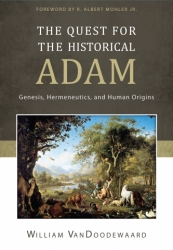Greetings, and welcome again to Books At a Glance as we continue our brief discussions about the Protestant Reformation. I’m Fred Zaspel, and we’ve been talking to Dr. William Vandoodewaard about the Dutch Reformation. This time he is here to talk to us about the Heidelberg Catechism.
First, maybe you can briefly summarize the historical context of the writing of the Heidelberg Catechism?
Vandoodewaard:
Sure, thanks Fred. I’ll be glad to do that. The writing of the Heidelberg Catechism really begins in around the early 1560s when Elector Frederick III, who lived from 1516 to 1576 at the Palatinate, desired that his subjects be led to devout knowledge and fear of the Almighty and his Holy Word of salvation. So, Elector Frederick III commissioned a group of theologians and ministers to write a catechetical summary of biblical truths, so that they could be committed to memory. Really encouraging individual faith and growth in Christ. That’s the inception – it comes from this prince. His vision was that it would not only function as a spiritual help for individuals, but also as a corporate confession of faith and truth, a doctrinal standard, to promote peace, purity, prosperity of the church.
Well, really there are two young men who are leading in the work of writing this catechism. Frederick commissions it, but it is Zacharias Ursinus and Caspar Olevianus, the one born in 1534, the other one in 1536, who played significant roles in this task. They work together as a team in drafting it and refining it; and then the final version will be approved by the 1563 Synod in Heidelberg, the city that lends its name to this catechism. It’s published both in German and Latin and later on we’ll see subsequent editions will divide this work into 52 sections or Lord’s Days, being intended for catechetical use week by week in Sunday afternoon teaching sessions.
Zaspel:
It would be difficult to find something, I think, more enjoyable to read, when it comes to reading theology, than the Heidelberg Catechism. Describe for us the content and other characteristics of the Heidelberg Catechism.
Vandoodewaard:
It’s true, the Heidelberg Catechism is wonderfully written; it’s warmly written, it’s devotionally written. There are other Reformation catechisms which do a beautiful job of teaching sound doctrine, but the Heidelberg Catechism does have the uniqueness, I would say, of this devotional warmth, this pastoral quality to it. You see the opening questions often cited in regard to that. “What is your only comfort in life and death?” It’s, “That I would, body and soul, both in life and death, am not my own, but belong to my faithful Savior, Jesus Christ, who, with his precious blood, has fully satisfied for all my sins, delivered me from all the power of the devil, and so preserves me. Without the will of my heavenly father, not a hair can fall from my head. Yes, that all things must be subservient to my salvation, and therefore by his Holy Spirit he also assures me of eternal life and makes me sincerely willing and ready, from now on to live for Him.” It’s just beautifully devotional. And you think of this being written, you know… What a pastoral mindset! This catechism is being written to a persecuted church, and just pointing them to Christ as their faithful Savior. A generation that would be wrestling with assurance of salvation because of the whole works/righteousness mentality that they have been steeped in. And to the sufficiency of Christ, the Father’s care for them, the work of the Holy Spirit, beautifully brought together there.
That really is the tenor of the catechism as we move through it. The writers followed the pattern of the book of Romans. So really you could say three sections to the catechism. They begin looking at the realities of our sin and misery. After this warm introduction, they turn to consider the reality of sin and what it is. From there they moved to salvation in Christ, including faith and repentance: and then in the concluding section, we’re looking at a life of thankful obedience to Christ. So, divided into those sections and, again, as I mentioned, while it has those three broader sections, it’s divided into 52, you could say, subsections so that it could be taught week by week. Actually, 129 questions and answers divided into 52 sections. It incorporates a number of the standard things that we would see in other Reformation catechisms. There’s an exposition of the Apostle’s Creed; an exposition of the Sacraments; and then in the section on Christian living, an exposition of the Ten Commandments and the Lord’s Prayer. And so, you could see that part of the goal is these foundational building blocks – Ten Commandments, the Lord’s Prayer, the Apostles Creed – that would also be commonly known, even in a Roman Catholic world, being encouraged to be memorized, to be understood in a thoroughly Scriptural and Christ centered way.
Zaspel:
What has been the impact and enduring value of this Reformation catechism?
Vandoodewaard:
Again, it’s a widely adopted catechism; it will be used by the German Reformed churches and again throughout the Low Countries; but we see beyond that, much of the reformed world really loving this catechism and making use of it, making reference to it. So, whether it’s English Puritans or Scottish Presbyterians, or others, Baptist catechisms that are formed, that there will be comparison made and theologians will look to this, and pastors, as they… It’s really a beautiful and helpful pastoral tool. I would argue that it’s probably, in terms of shaping the character and influencing the Dutch Reformed churches, both in the Low Countries, the Netherlands, and more globally as they’d spread into North America, Australia, South Africa, and other places like that, the Heidelberg catechism takes a very key role. And many of those churches would use it as not only a teaching tool, but would actually take those Lord’s Days and have teaching sermons on them in their evening worship services.
Zaspel:
Okay, let’s take a longer look ahead to post-Reformation developments in light of what we’ve already discussed. Tell us about the Canons of Dort and then The Three Forms of Unity.
Vandoodewaard:
We’ve looked at, in our segments together, the formation of the Belgic Confession of Faith and now the Heidelberg catechism, which really is a German Reformed document which becomes adopted by the Dutch Reformed. If we would fast-forward in time further into the post-Reformation era, the beginning of the 1600s. In the Low Countries you have this controversy that arises between what are called the Remonstrance, who are really Arminians in their theology, and Reformed proper in the Dutch Reformed Church. That controversy leads to a synod taking place, the Synod of Dort, to which international delegates from other reformed backgrounds are invited. There’s a delegation from England, there are delegates from other parts of Europe that are coming to this Synod. And this Synod tackles the five points of the Remonstrance, these teachings which reject the historic Scriptural understanding of the Sovereignty of God; understanding of election, predestination and the way God works out his work of grace in the lives of individuals. So really the application of redemption. This becomes really summed up, codified, in what we know as the Canons of Dort. It’s an interesting, really systematic, theological statement; it’s pastorally oriented as well; but it really focuses on these areas of God’s sovereignty and how does that relate to the doctrines of grace. Well, that document, formulated at the Synod of Dort in 1618 – 1619, becomes part of this triad of the Belgic Confession, Heidelberg Catechism, and now the Canons of Dort which become known as The Three Forms of Unity. Today, if you would go to a Dutch Reformed Church, whether it’s United Reformed, Free Reformed, Christian Reformed, or others, they would hold to The Three Forms of Unity as a confessional standard or basis. Depending upon the denomination to what extent they hold to it more robustly or more loosely, but a very influential document, the Three Forms of Unity bringing the three together. Canons of Dort, as well, of course, having a significant influence again on English Puritanism and Scottish Presbyterianism as they would deal with similar issues into the era of the Westminster Assembly.
Zaspel:
We’re talking to Dr. William Vandoodewaard about the Dutch Reformation. This is his third discussion with us, and if you missed the previous two you will definitely want to catch up with them here on Books At a Glance. Dr. Vandoodewaard is also the author of some important books you’ll want to check out here on this page. In fact, we have interviewed him before about one of those books, particularly The Quest for the Historical Adam. His book is an important work on a very contemporary subject which needs to be dealt with and he’s dealt with it very well. You’ll want to check that out.
Bill, you’ve been a great guide for us on the Dutch Reformation—thanks so much for helping us out.
Vandoodewaard:
You’re welcome, Fred. It’s been a privilege to be with you and great to get a little Dutch plug onto Books At a Glance.
Editor’s Note: Be sure to take a look at these books by Dr. Vandoodewaard.
The Quest for the Historical Adam
Books At a Glance Author Interview.
The Marrow Controversy and Seceder Tradition

